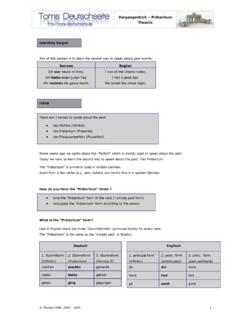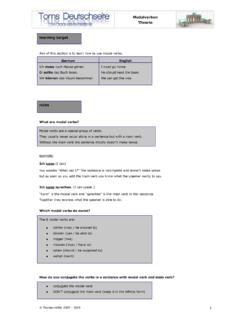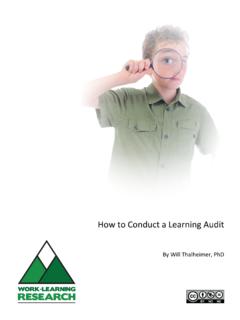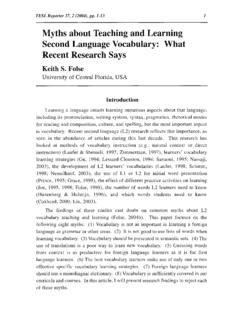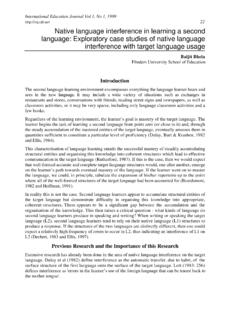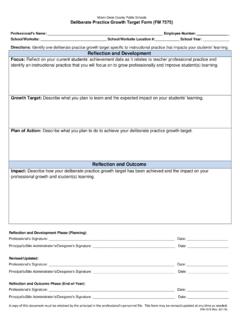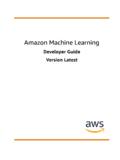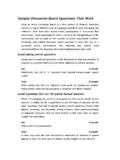Transcription of arXiv:1509.02971v5 [cs.LG] 29 Feb 2016
1 Published as a conference paper at ICLR 2016 CONTINUOUS CONTROL WITH DEEP REINFORCEMENTLEARNINGT imothy P. Lillicrap , Jonathan J. Hunt , Alexander Pritzel, Nicolas Heess,Tom Erez, Yuval Tassa, David Silver & Daan WierstraGoogle DeepmindLondon, UK{countzero, jjhunt, apritzel, heess,etom, tassa, davidsilver, wierstra}@ adapt the ideas underlying the success of Deep Q- learning to the continuousaction domain. We present an actor-critic, model-free algorithm based on the de-terministic policy gradient that can operate over continuous action spaces. Usingthe same learning algorithm, network architecture and hyper-parameters, our al-gorithm robustly solves more than 20 simulated physics tasks, including classicproblems such as cartpole swing-up, dexterous manipulation, legged locomotionand car driving.
2 Our algorithm is able to find policies whose performance is com-petitive with those found by a planning algorithm with full access to the dynamicsof the domain and its derivatives. We further demonstrate that for many of thetasks the algorithm can learn policies end-to-end : directly from raw pixel of the primary goals of the field of artificial intelligence is to solve complex tasks from unpro-cessed, high-dimensional, sensory input. Recently, significant progress has been made by combin-ing advances in deep learning for sensory processing (Krizhevsky et al., 2012) with reinforcementlearning, resulting in the Deep Q Network (DQN) algorithm (Mnih et al.)
3 , 2015) that is capable ofhuman level performance on many Atari video games using unprocessed pixels for input. To do so,deep neural network function approximators were used to estimate the action-value , while DQN solves problems with high-dimensional observation spaces, it can only handlediscrete and low-dimensional action spaces. Many tasks of interest, most notably physical controltasks, have continuous (real valued) and high dimensional action spaces. DQN cannot be straight-forwardly applied to continuous domains since it relies on a finding the action that maximizes theaction-value function, which in the continuous valued case requires an iterative optimization processat every obvious approach to adapting deep reinforcement learning methods such as DQN to continuousdomains is to to simply discretize the action space.
4 However, this has many limitations, most no-tably the curse of dimensionality: the number of actions increases exponentially with the numberof degrees of freedom. For example, a 7 degree of freedom system (as in the human arm) with thecoarsest discretizationai { k,0,k}for each joint leads to an action space with dimensionality:37= 2187. The situation is even worse for tasks that require fine control of actions as they requirea correspondingly finer grained discretization, leading to an explosion of the number of discreteactions. Such large action spaces are difficult to explore efficiently, and thus successfully trainingDQN-like networks in this context is likely intractable.
5 Additionally, naive discretization of actionspaces needlessly throws away information about the structure of the action domain, which may beessential for solving many this work we present a model-free, off-policy actor-critic algorithm using deep function approx-imators that can learn policies in high-dimensional, continuous action spaces. Our work is based These authors contributed [ ] 29 Feb 2016 Published as a conference paper at ICLR 2016on the deterministic policy gradient (DPG) algorithm (Silver et al., 2014) (itself similar to NFQCA(Hafner & Riedmiller, 2011), and similar ideas can be found in (Prokhorov et al.))
6 , 1997)). However,as we show below, a naive application of this actor-critic method with neural function approximatorsis unstable for challenging we combine the actor-critic approach with insights from the recent success of Deep Q Network(DQN) (Mnih et al., 2013; 2015). Prior to DQN, it was generally believed that learning valuefunctions using large, non-linear function approximators was difficult and unstable. DQN is ableto learn value functions using such function approximators in a stable and robust way due to twoinnovations: 1. the network is trained off-policy with samples from a replay buffer to minimizecorrelations between samples; 2.
7 The network is trained with a target Q network to give consistenttargets during temporal difference backups. In this work we make use of the same ideas, along withbatch normalization (Ioffe & Szegedy, 2015), a recent advance in deep order to evaluate our method we constructed a variety of challenging physical control problemsthat involve complex multi-joint movements, unstable and rich contact dynamics, and gait these are classic problems such as the cartpole swing-up problem, as well as many newdomains. A long-standing challenge of robotic control is to learn an action policy directly from rawsensory input such as video.
8 Accordingly, we place a fixed viewpoint camera in the simulator andattempted all tasks using both low-dimensional observations ( joint angles) and directly model-free approach which we call Deep DPG (DDPG) can learn competitive policies for all ofour tasks using low-dimensional observations ( cartesian coordinates or joint angles) using thesame hyper-parameters and network structure. In many cases, we are also able to learn good policiesdirectly from pixels, again keeping hyperparameters and network structure key feature of the approach is its simplicity: it requires only a straightforward actor-critic archi-tecture and learning algorithm with very few moving parts , making it easy to implement and scaleto more difficult problems and larger networks.
9 For the physical control problems we compare ourresults to a baseline computed by a planner (Tassa et al., 2012) that has full access to the underly-ing simulated dynamics and its derivatives (see supplementary information). Interestingly, DDPGcan sometimes find policies that exceed the performance of the planner, in some cases even whenlearning from pixels (the planner always plans over the underlying low-dimensional state space).2 BACKGROUNDWe consider a standard reinforcement learning setup consisting of an agent interacting with an en-vironmentEin discrete timesteps. At each timesteptthe agent receives an observationxt, takesan actionatand receives a scalar rewardrt.
10 In all the environments considered here the actionsare real-valuedat IRN. In general, the environment may be partially observed so that the entirehistory of the observation, action pairsst= (x1,a1,..,at 1,xt)may be required to describe thestate. Here, we assumed the environment is fully-observed sost= agent s behavior is defined by a policy, , which maps states to a probability distribution overthe actions :S P(A). The environment,E, may also be stochastic. We model it as a Markovdecision process with a state spaceS, action spaceA=IRN, an initial state distributionp(s1),transition dynamicsp(st+1|st,at), and reward functionr(st,at).


![arXiv:0706.3639v1 [cs.AI] 25 Jun 2007](/cache/preview/4/1/3/9/3/1/4/b/thumb-4139314b93ef86b7b4c2d05ebcc88e46.jpg)
![arXiv:1301.3781v3 [cs.CL] 7 Sep 2013](/cache/preview/4/d/5/0/4/3/4/0/thumb-4d504340120163c0bdf3f4678d8d217f.jpg)
![@google.com arXiv:1609.03499v2 [cs.SD] 19 Sep 2016](/cache/preview/c/3/4/9/4/6/9/b/thumb-c349469b499107d21e221f2ac908f8b2.jpg)





